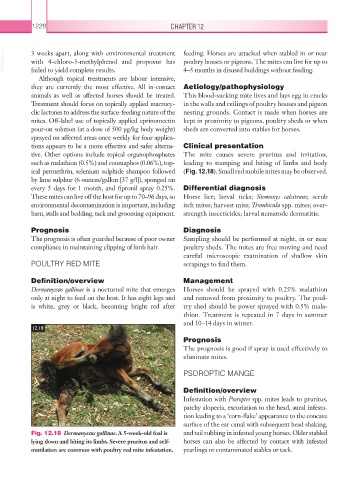Page 1253 - Equine Clinical Medicine, Surgery and Reproduction, 2nd Edition
P. 1253
1228 CHAPTER 12
VetBooks.ir 3 weeks apart, along with environmental treatment feeding. Horses are attacked when stabled in or near
poultry houses or pigeons. The mites can live for up to
with 4-chloro-3-methylphenol and propoxur has
failed to yield complete results.
Although topical treatments are labour intensive, 4–5 months in disused buildings without feeding.
they are currently the most effective. All in-contact Aetiology/pathophysiology
animals as well as affected horses should be treated. This blood-sucking mite lives and lays egg in cracks
Treatment should focus on topically applied macrocy- in the walls and ceilings of poultry houses and pigeon
clic lactones to address the surface-feeding nature of the nesting grounds. Contact is made when horses are
mites. Off-label use of topically applied eprinomectin kept in proximity to pigeons, poultry sheds or when
pour-on solution (at a dose of 500 μg/kg body weight) sheds are converted into stables for horses.
sprayed on affected areas once weekly for four applica-
tions appears to be a more effective and safer alterna- Clinical presentation
tive. Other options include topical organophosphates The mite causes severe pruritus and irritation,
such as malathion (0.5%) and coumaphos (0.06%), top- leading to stamping and biting of limbs and body
ical permethrin, selenium sulphide shampoo followed (Fig. 12.18). Small red mobile mites may be observed.
by lime sulphur (6 ounces/gallon [37 g/l]), sponged on
every 5 days for 1 month, and fipronil spray 0.25%. Differential diagnosis
These mites can live off the host for up to 70–96 days, so Horse lice; larval ticks; Stomoxys calcitrans; scrub
environmental decontamination is important, including itch mites; harvest mite; Trombicula spp. mites; over-
barn, stalls and bedding, tack and grooming equipment. strength insecticides; larval nematode dermatitis.
Prognosis Diagnosis
The prognosis is often guarded because of poor owner Sampling should be performed at night, in or near
compliance in maintaining clipping of limb hair. poultry sheds. The mites are free moving and need
careful microscopic examination of shallow skin
POULTRY RED MITE scrapings to find them.
Definition/overview Management
Dermanyssus gallinae is a nocturnal mite that emerges Horses should be sprayed with 0.25% malathion
only at night to feed on the host. It has eight legs and and removed from proximity to poultry. The poul-
is white, grey or black, becoming bright red after try shed should be power sprayed with 0.5% mala-
thion. Treatment is repeated in 7 days in summer
and 10–14 days in winter.
12.18
Prognosis
The prognosis is good if spray is used effectively to
eliminate mites.
PSOROPTIC MANGE
Definition/overview
Infestation with Psoroptes spp. mites leads to pruritus,
patchy alopecia, excoriation to the head, aural infesta-
tion leading to a ‘corn-flake’ appearance to the concave
surface of the ear canal with subsequent head shaking,
Fig. 12.18 Dermanyssus gallinae. A 5-week-old foal is and tail rubbing in infested young horses. Older stabled
lying down and biting its limbs. Severe pruritus and self- horses can also be affected by contact with infested
mutilation are common with poultry red mite infestation. yearlings or contaminated stables or tack.

